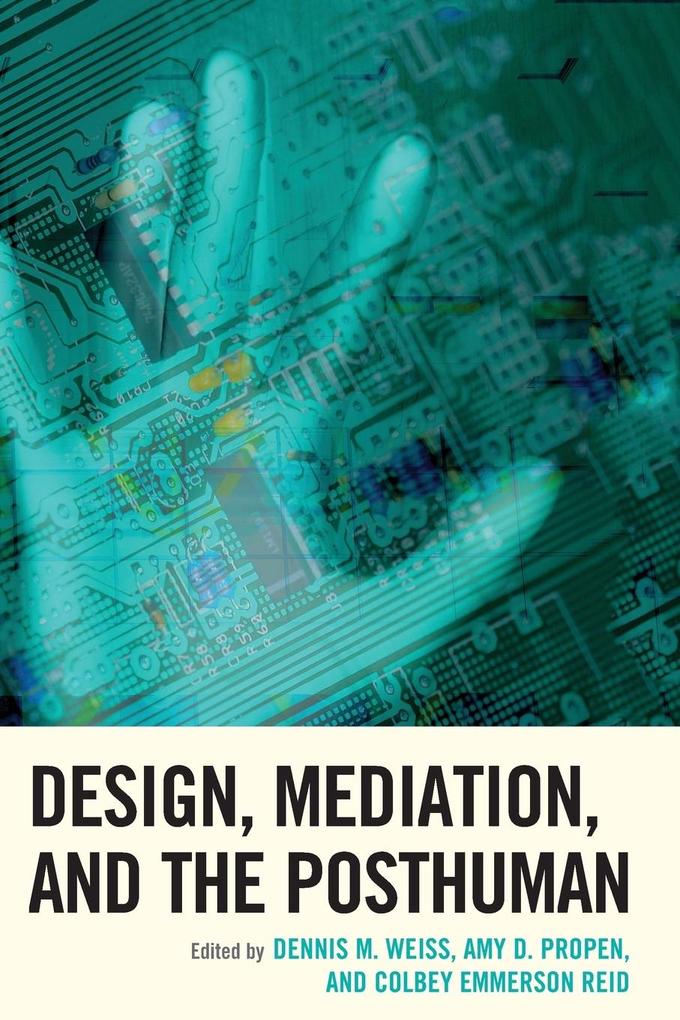
Zustellung: Do, 20.03. - Mo, 24.03.
Versand in 6 Tagen
VersandkostenfreiBestellen & in Filiale abholen:
Though the progress of technology continually pushes life toward virtual existence, the last decade has witnessed a renewed focus on materiality. Design, Mediation, and the Posthuman bears witness to the attention paid by literary theorists, digital humanists, rhetoricians, philosophers, and designers to the crafted environment, the manner in which artifacts mediate human relations, and the constitution of a world in which the boundary between humans and things has seemingly imploded. The chapters reflect on questions about the extent to which we ought to view humans and nonhuman artifacts as having equal capacity for agency and life, and the ways in which technological mediation challenges the central tenets of humanism and anthropocentrism.
Contemporary theories of human-object relations presage the arrival of the posthuman, which is no longer a futuristic or science-fictional concept but rather one descriptive of the present, and indeed, the past. Discussions of the posthuman already have a long history in fields like literary theory, rhetoric, and philosophy, and as advances in design and technology result in increasingly engaging artifacts that mediate more and more aspects of everyday life, it becomes necessary to engage in a systematic, interdisciplinary, critical examination of the intersection of the domains of design, technological mediation, and the posthuman. Thus, this collection brings diverse disciplines together to foster a dialogue on significant technological issues pertinent to philosophy, rhetoric, aesthetics, and science.
Contemporary theories of human-object relations presage the arrival of the posthuman, which is no longer a futuristic or science-fictional concept but rather one descriptive of the present, and indeed, the past. Discussions of the posthuman already have a long history in fields like literary theory, rhetoric, and philosophy, and as advances in design and technology result in increasingly engaging artifacts that mediate more and more aspects of everyday life, it becomes necessary to engage in a systematic, interdisciplinary, critical examination of the intersection of the domains of design, technological mediation, and the posthuman. Thus, this collection brings diverse disciplines together to foster a dialogue on significant technological issues pertinent to philosophy, rhetoric, aesthetics, and science.
Inhaltsverzeichnis
Introduction: MIND versus THING and Other 'Central Events' of the Twenty-First Century
Part One: Interface
Introduction
Chapter One: Posthuman Topologies: Thinking Through the Hoard, Anthony Miccoli
Chapter Two: The Rhetorical Work of the GPS: Geographic Knowledge-Making and the Technologically-Mediated Body, Amy D. Propen
Chapter Three: Neo-Baroque Computing: Interface and the Subject-Object Divide, Elise Takehana
Chapter Four: Techno-Geographic Interfaces: Layers of Text and Agency in Mobile Augmented Reality, John Tinnell
Part Two: Artifact
Introduction
Chapter Five: The Plastic Art of LEGO: An Essay into Material Culture, Jonathan Rey Lee
Chapter Six: The iPhone Erfahrung: Siri, the Auditory Unconscious, and Walter Benjamin's "Aura", Emily McArthur
Chapter Seven: Victorian Cybernetics: Networking Technology, Disability and Interior Design, Colbey Emmerson Reid
Chapter Eight: Extending "Extension": A Reappraisal of the Technology-as-Extension Idea through the Case of Self-Tracking Technologies, Yoni Van Den Eede
Part Three: Users
Introduction
Chapter Nine: Mobility Regimes and the Constitution of the Nineteenth-Century Posthuman Body, Kristie Fleckenstein and Josh Mehler
Chapter Ten: Living Deliberately, Less or More: Affirmative Cynicism and Radical Design, Matthew A. Levy
Chapter Eleven: Seduced by the Machine: Human-Technology Relations and Sociable Robots, Dennis M. Weiss
Chapter Twelve: "You really are you, right?": Cybernetic Memory and the Construction of the Posthuman Self in Videogame Play, Brendan Keogh
Chapter Thirteen: Mediating Anthropocene Planetary Attachments: Lars von Trier's Melancholia, Nicole Merola
Part One: Interface
Introduction
Chapter One: Posthuman Topologies: Thinking Through the Hoard, Anthony Miccoli
Chapter Two: The Rhetorical Work of the GPS: Geographic Knowledge-Making and the Technologically-Mediated Body, Amy D. Propen
Chapter Three: Neo-Baroque Computing: Interface and the Subject-Object Divide, Elise Takehana
Chapter Four: Techno-Geographic Interfaces: Layers of Text and Agency in Mobile Augmented Reality, John Tinnell
Part Two: Artifact
Introduction
Chapter Five: The Plastic Art of LEGO: An Essay into Material Culture, Jonathan Rey Lee
Chapter Six: The iPhone Erfahrung: Siri, the Auditory Unconscious, and Walter Benjamin's "Aura", Emily McArthur
Chapter Seven: Victorian Cybernetics: Networking Technology, Disability and Interior Design, Colbey Emmerson Reid
Chapter Eight: Extending "Extension": A Reappraisal of the Technology-as-Extension Idea through the Case of Self-Tracking Technologies, Yoni Van Den Eede
Part Three: Users
Introduction
Chapter Nine: Mobility Regimes and the Constitution of the Nineteenth-Century Posthuman Body, Kristie Fleckenstein and Josh Mehler
Chapter Ten: Living Deliberately, Less or More: Affirmative Cynicism and Radical Design, Matthew A. Levy
Chapter Eleven: Seduced by the Machine: Human-Technology Relations and Sociable Robots, Dennis M. Weiss
Chapter Twelve: "You really are you, right?": Cybernetic Memory and the Construction of the Posthuman Self in Videogame Play, Brendan Keogh
Chapter Thirteen: Mediating Anthropocene Planetary Attachments: Lars von Trier's Melancholia, Nicole Merola
Mehr aus dieser Reihe
Produktdetails
Erscheinungsdatum
29. August 2016
Sprache
englisch
Seitenanzahl
326
Reihe
Postphenomenology and the Philosophy of Technology
Herausgegeben von
Amy D. Propen, Colbey Emmerson Reid, Dennis M. Weiss
Verlag/Hersteller
Produktart
kartoniert
Gewicht
474 g
Größe (L/B/H)
229/152/18 mm
ISBN
9781498501156
Entdecken Sie mehr
Bewertungen
0 Bewertungen
Es wurden noch keine Bewertungen abgegeben. Schreiben Sie die erste Bewertung zu "Design, Mediation, and the Posthuman" und helfen Sie damit anderen bei der Kaufentscheidung.














